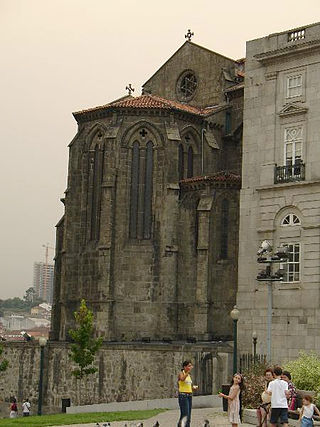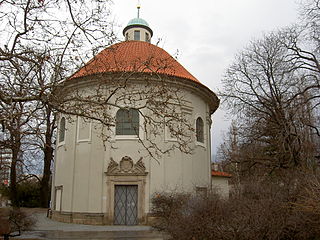


The Angel Church (German : Engelkirche) is an Evangelical-Lutheran church in Hinterhermsdorf which overlooks this Saxon village. Its name, unusual for a Protestant church, comes from the Baroque baptismal angel that decorates the interior.



The Angel Church (German : Engelkirche) is an Evangelical-Lutheran church in Hinterhermsdorf which overlooks this Saxon village. Its name, unusual for a Protestant church, comes from the Baroque baptismal angel that decorates the interior.
Angel Church is an aisleless church with a straight apse (Schluss) and arched windows. It supports a gabled roof with a flèche that is decorated by a lantern. The interior has a Baroque three-winged altar (probably by a Bohemian master craftsman) dated 1681 to 1692 and by a Baroque baptismal angel, which gives the church its name. The 1846 organ was built by Samuel Heinrich Herold. [1]
The Angel Church was built after 1688 on a rise above Hinterhermsdorf. The architect was Hans Hamann from Tharandt. In 1846 there were numerous modifications that were largely reverted during alterations in 1939. At the end of the 1970s restoration work began that was finished in 1988. [1]

Baroque architecture is a highly decorative and theatrical style which appeared in Italy in the late 16th century and gradually spread across Europe. It was originally introduced by the Catholic Church, particularly by the Jesuits, as a means to combat the Reformation and the Protestant church with a new architecture that inspired surprise and awe. It reached its peak in the High Baroque (1625–1675), when it was used in churches and palaces in Italy, Spain, Portugal, France, Bavaria and Austria. In the Late Baroque period (1675–1750), it reached as far as Russia, the Ottoman Empire and the Spanish and Portuguese colonies in Latin America. In about 1730, an even more elaborately decorative variant called Rococo appeared and flourished in Central Europe.

Saint-Nicolas du Chardonnet is a Catholic church in the centre of Paris, France, in the 5th arrondissement. It was constructed between 1656 and 1763. The facade was designed in the classical style by Charles Le Brun. It contains many notable art works from the 19th century, including a rare religious painting by Jean-Baptiste Corot.

The Church of the Gesù is the mother church of the Society of Jesus (Jesuits), a Catholic religious order. Officially named Chiesa del Santissimo Nome di Gesù, its façade is "the first truly baroque façade", introducing the baroque style into architecture. The church served as a model for innumerable Jesuit churches all over the world, especially in the central Europe and then in the Portuguese colonies. Its paintings in the nave, crossing, and side chapels became models for Jesuit churches throughout Italy and Europe, as well as those of other orders. The Church of the Gesù is located in the Piazza del Gesù in Rome and is one of the great 17th century preaching churches built by Counter-Reformation orders in the Centro Storico.

St John's Co-Cathedral is a Catholic co-cathedral in Valletta, Malta, dedicated to Saint John the Baptist. It was built by the Order of St. John between 1573 and 1578, having been commissioned by Grand Master Jean de la Cassière as the Conventual Church of Saint John.

Sebnitz is a town in the Sächsische Schweiz-Osterzgebirge district, in Saxony, Germany.

The Church of Saint Francis is the most prominent Gothic monument in Porto, Portugal, being also noted for its outstanding Baroque inner decoration. It is located in the historic centre of the city, declared World Heritage Site by UNESCO.

The Collegiate Church of St. Bartholomew is a Roman Catholic collegiate church in Liège, Belgium. Founded outside the city walls, it was built in coal sandstone, starting in the late 11th century and lasting until the late 12th century. It underwent, like most ancient religious buildings, modifications through the centuries. Nevertheless, the Meuse Romanesque—Ottonian architecture character of its architecture remained deeply rooted. The 18th century saw the addition of two more aisles, the opening of a neoclassical portal in the walls of the westwork, and the French Baroque redecoration of the interior. The interior of the western section has recently been restored back to the original style.

Saint-Louis en l'Île is a Roman Catholic parish church located at 19 Rue Saint-Louis en l'Île on Île Saint-Louis in the 4th arrondissement of Paris, France. It was constructed between 1664 and 1725, and is dedicated to King Louis IX of France, or Saint Louis. The church was originally built in the French Baroque style of the 17th century, but much of the interior decoration was taken or destroyed in the French Revolution. The church was extensively restored and redecorated in the 19th century.

The Franciscan Church of the Annunciation is a Franciscan church located on Prešeren Square in Ljubljana, the capital of Slovenia. It is the parish church of Ljubljana - Annunciation Parish. It was built on a site where two or possibly three churches stood earlier between 1646 and 1660 under the management of Francesco Olivieri and Francesco Rosina, and its exterior was redesigned in 1858 according to plans by Franz Kurz zum Thurn und Goldenstein. The frescoes in the interior were added in the mid-19th century by Matevž Langus and on the ceiling by Matej Sternen in the first half of the 20th century, whereas the main altar was mostly made by the Baroque sculptor Francesco Robba (1736). The red or pink colour of the church is symbolic of the Franciscan monastic order. Since 2008, the church has been protected as a cultural monument of national significance of Slovenia.

St Francis Xavier Church is a parish Roman Catholic church in the 7th arrondissement of Paris dedicated to Francis Xavier, the patron saint of missions. Built in the late 19th century, It gave its name to the nearby Metro station Saint-François-Xavier. It contains the tomb of Madeleine Sophie Barat, a French saint of the Catholic Church and founder of the Society of the Sacred Heart, a worldwide religious institute of educators. It is also known for its collection of Italian Baroque and Mannerist paintings, including a work by Tintoretto. The church was inscribed as an historic monument in 2018.

The Church of Saint Roch, located on Olšany Square, is the oldest church in present-day Žižkov, a cadastral district of Prague, Czech Republic. The Baroque structure was built between 1680 and 1682 by Jan Hainric, probably according to plans by the renowned French architect Jean Baptiste Mathey.

The Co-Cathedral of Saint Nicholas in Prešov is one of the oldest and most important churches in Slovakia. The external dimensions of the cathedral are 54.7m in length and 34.45m in width. The indoor nave is 16 m tall and the tower reaches a height of 71 meters. The temple's design takes inspiration from the Late Gothic hall churches with three naves.

Notre-Dame-de-Lorette is a Roman Catholic church located in the 9th arrondissement of Paris, It was built between 1823 and 1836 in the Neo-classical architectural style by architect Louis-Hippolyte Lebas, in a neighbourhood known as the New Athens, for its many artistic and scholarly residents in the 19th century, including George Sand, Pierre-Auguste Renoir, and Alexandre Dumas. While the exterior is classical and austere, the church interior is known for its rich collection of paintings, sculpture, and polychrome decoration.
Ulbersdorf is a village in Saxon Switzerland in the district of Sächsische Schweiz-Osterzgebirge in southeastern Saxony, Germany. It was mentioned first in 1432 as Olbersdorff and is part of the town of Hohnstein since 1994.

Östra Hoby Church is a medieval Lutheran church built in the Romanesque style. Located 4 km east of Borrby in Skåne County in southern Sweden, it belongs to the Diocese of Lund. The church is noted for its murals and for its sculpted baptismal font.

The Church of St Apollinaire is located in New Town in Prague in the street Apolinarska on the hill called Vetrov. This Gothic church was built approximately between years 1360–1390. The church was established by Charles IV in 1362. Nowadays Roman Catholic Church is located here but it was administrated also by the Chemin Neuf community. The church is protected as a cultural heritage since 1958.
San Michele Arcangelo is a baroque-style Roman Catholic church located on Largo Vinci #3 in Fermo, province of Fermo, in the region of Marche, Italy.

Bjäresjö Church is a medieval church in Bjäresjö, in the province of Skåne, Sweden. The church contains several medieval mural paintings as well as a richly decorated Romanesque baptismal font.

The St. Catherine of Alexandria Church is a Roman Catholic church in the Tabán quarter of Budapest, Hungary. It is the parish church of the Tabán Parish which also comprises parts of Gellért Hill and Naphegy. The church is a listed monument that was built in Central European Baroque style between 1728 and 1777. It was reconstructed several times in the 19th–20th centuries.

Hurum Church is a medieval stone church in Hurum, Norway. It was constructed in the 12th century. The church was damaged by fire in 1686, and rebuilt with a baroque interior. Next to the church, the Huitfeldt-family built a wooden funeral chapel in the second half of the 17th century. A new stone chapel was built in 1750, and contains the remains of the naval commander Iver Huitfeldt.